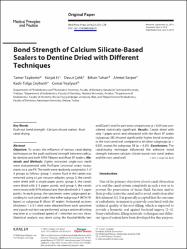| dc.contributor.author | Taşdemir, Tamer | |
| dc.contributor.author | Er, Kürşat | |
| dc.contributor.author | Çelik, Davut | |
| dc.contributor.author | Tahan, Erhan | |
| dc.contributor.author | Serper, Ahmet | |
| dc.contributor.author | Ceyhanlı, Kadir Tolga | |
| dc.contributor.author | Yesilyurt, Cemal | |
| dc.date.accessioned | 2020-12-19T20:03:34Z | |
| dc.date.available | 2020-12-19T20:03:34Z | |
| dc.date.issued | 2014 | |
| dc.identifier.citation | Tasdemir, T., Er, K., Celik, D., Tahan, E., Serper, A., Ceyhanli, K.T., Yesilyurt, C., (2014). Bond Strength of Calcium Silicate-Based Sealers to Dentine Dried with Different Techniques. Medical Principles and Practice, 23(4), 373-376. https://doi.org/10.1159/000362619, | |
| dc.identifier.issn | 1011-7571 | |
| dc.identifier.issn | 1423-0151 | |
| dc.identifier.uri | https://doi.org/10.1159/000362619 | |
| dc.identifier.uri | https://hdl.handle.net/11436/3198 | |
| dc.description | Er, Kursat/0000-0002-0667-4909; Tasdemir, Tamer/0000-0001-8512-5280; Yesilyurt, Cemal/0000-0001-5435-9009 | en_US |
| dc.description | WOS: 000339731600015 | en_US |
| dc.description | PubMed: 24903084 | en_US |
| dc.description.abstract | Objective: To assess the influence of various canal-drying techniques on the push-out bond strength between radicular dentine and both MTA Fillapex and iRoot SP sealers. Materials and Methods: Eighty extracted single-root teeth were instrumented with ProTaper Universal rotary instruments to a size F4. the teeth were randomly assigned to 1 of 4 groups as follows: group 1, excess fluid in the canals was removed using a Luer vacuum adapter; group 2, the canals were dried with a single paper point; group 3, the canals were dried with 3-5 paper points, and group 4, the canals were rinsed with 95% ethanol and then dried with 3-5 paper points. in each group, the specimens were subgrouped according to root canal sealer into either subgroup A (MTA Fillapex) or subgroup B (iRoot SP sealer). Horizontal sections (thickness 1 +/- 0.1 mm) were obtained from each specimen and a push-out test was performed using a universal testing machine at a crosshead speed of 1 mm/min on root slices. Statistical analysis was done using the Kruskal-Wallis test and Dunn's test for pair-wise comparisons. p < 0.05 was considered statistically significant. Results: Canals dried with only 1 paper point and obturated with the iRoot SP sealer (subgroup 2B) showed significantly higher bond strengths to the root canal wall compared to all other subgroups (p < 0.05), except for subgroup 1B (p > 0.05). Conclusions: the canal-drying technique influenced the adhesive bond strength between calcium silicate-based root canal sealers and the root canal wall. (C) 2014 S. Karger AG, Basel | en_US |
| dc.language.iso | eng | en_US |
| dc.publisher | Karger | en_US |
| dc.rights | info:eu-repo/semantics/openAccess | en_US |
| dc.subject | Push-out bond strength | en_US |
| dc.subject | Calcium silicate sealers | en_US |
| dc.subject | Root canal drying | en_US |
| dc.title | Bond strength of calcium silicate-based sealers to dentine dried with different techniques | en_US |
| dc.type | article | en_US |
| dc.contributor.department | RTEÜ, Diş Hekimliği Fakültesi, Klinik Bilimler Bölümü | en_US |
| dc.contributor.institutionauthor | Tahan, Erhan | |
| dc.identifier.doi | 10.1159/000362619 | |
| dc.identifier.volume | 23 | en_US |
| dc.identifier.issue | 4 | en_US |
| dc.identifier.startpage | 373 | en_US |
| dc.identifier.endpage | 376 | en_US |
| dc.ri.edit | oa | en_US |
| dc.relation.journal | Medical Principles and Practice | en_US |
| dc.relation.publicationcategory | Makale - Uluslararası Hakemli Dergi - Kurum Öğretim Elemanı | en_US |


















